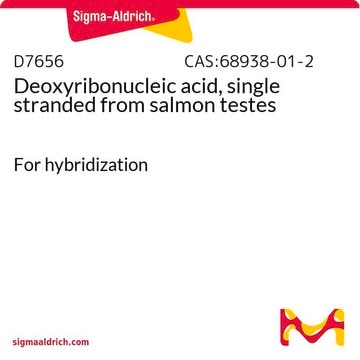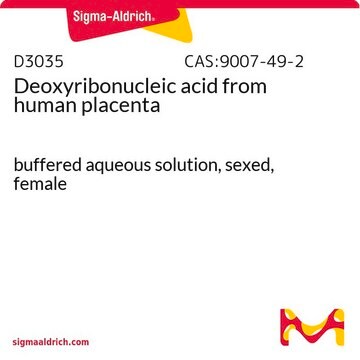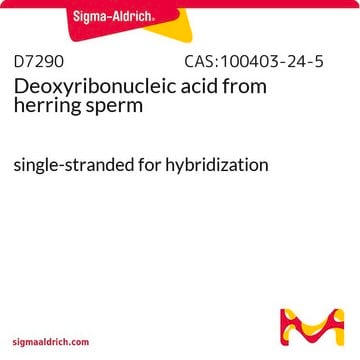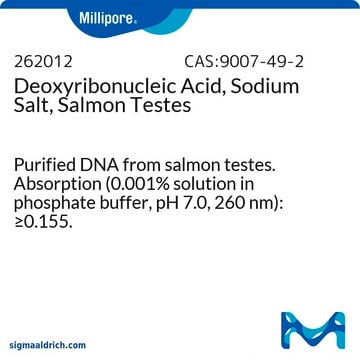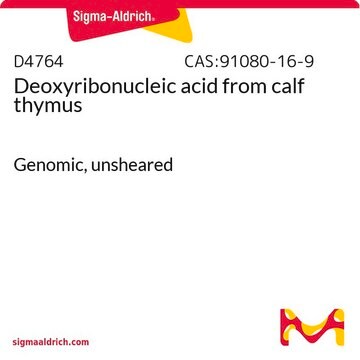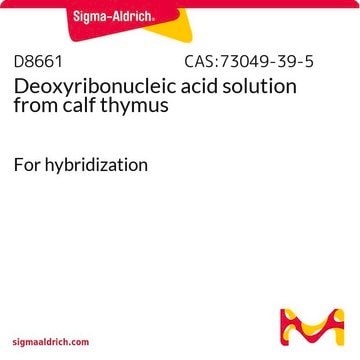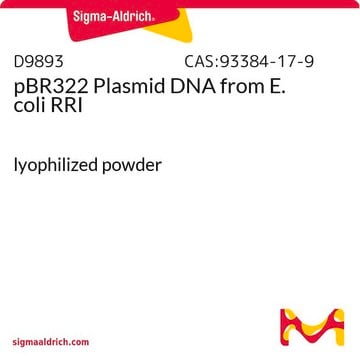D4889
Deoxyribonucleic acid sodium salt from Escherichia coli strain B
Genomic, unsheared
Sinónimos:
DNA
Iniciar sesiónpara Ver la Fijación de precios por contrato y de la organización
About This Item
Número de CAS:
EC Number:
MDL number:
UNSPSC Code:
41106310
eCl@ss:
32160414
NACRES:
NA.52
Productos recomendados
¿Está buscando productos similares? Visita Guía de comparación de productos
Categorías relacionadas
General description
Escherichia coli strain B is most widely studied DNA after k-12. The genomes of E coli strain B and k-12 show differences in the IS sequence elements. Strain B have B-islands and express O-specific side-chain LPS. The product is unsheared genomic DNA.
Specificity
50% GC; Tm = 90.5 °C
Application
The DNAs are particularly useful for genomic analysis, including PCR, library construction in bacteriophage λ, and in heterologous pre-hybridization and hybridization protocols.
Deoxyribonucleic acid sodium salt from Escherichia coli strain B has been used for:
Deoxyribonucleic acid sodium salt from Escherichia coli strain B has been used for:
- PCR reactions of genomic DNA of Gardnerella vaginalis
- nick translation and radiolabeling of dNTP
- generating standard curve for 16S rDNA quantification
- transfecting neutrophils
- testing the extraction methods
Unit Definition
One unit will yield an A260 of 1.0 in 1.0 ml of 1 mM Tris-HCl, pH 7.5, with 1 mM NaCl and 1 mM EDTA (1 cm light path).
Preparation Note
Purified by anion exchange chromatography, dialyzed against a solution of 1 mM sodium chloride, 1 mM EDTA and 1 mM Trizma HCl, pH 7.5 and lyophilized at a concentration of approx. 2 units per mL. Approx. 20 A260 units per mg DNA. % GC is the percentage of G/C base pairs. Tm is the temperature at the midpoint of the thermal denaturation profile.
Analysis Note
Analyzed by gel electrophoresis and visualization after ethidium bromide staining, with single predominant band of 45 kB or greater.
Other Notes
DNA in solution will reanneal on standing at room temperature so it is recommended to boil the solution for 10 minutes and then cool on ice for at least 5 minutes prior to use.
related product
Referencia del producto
Descripción
Precios
Storage Class
11 - Combustible Solids
wgk_germany
WGK 3
flash_point_f
Not applicable
flash_point_c
Not applicable
ppe
Eyeshields, Gloves, type N95 (US)
Certificados de análisis (COA)
Busque Certificados de análisis (COA) introduciendo el número de lote del producto. Los números de lote se encuentran en la etiqueta del producto después de las palabras «Lot» o «Batch»
¿Ya tiene este producto?
Encuentre la documentación para los productos que ha comprado recientemente en la Biblioteca de documentos.
Los clientes también vieron
Johan Sukweenadhi et al.
Antonie van Leeuwenhoek, 106(5), 935-945 (2014-08-30)
Strain DCY84(T), a Gram-stain positive, rod-shaped, aerobic, spore-forming bacterium, motile by means of peritrichous flagella, was isolated from humus soil from Yongin forest in Gyeonggi province, South Korea. Strain DCY84(T) shared the highest sequence similarity with Paenibacillus barengoltzii KACC 15270(T)
Rudolph Spangler et al.
PloS one, 4(9), e7010-e7010 (2009-09-16)
PCR in principle can detect a single target molecule in a reaction mixture. Contaminating bacterial DNA in reagents creates a practical limit on the use of PCR to detect dilute bacterial DNA in environmental or public health samples. The most
Mohamed El-Agamy Farh et al.
Journal of microbiology (Seoul, Korea), 55(10), 767-774 (2017-09-29)
Gram-staining-negative, uniflagellated, rod-shaped, designated as DCY110
Genomic comparisons among Escherichia coli strains B, K-12, and O157: H7 using IS elements as molecular markers
Schneider D, et al.
BMC Microbiology, 2(1), 18-18 (2002)
Yue Huo et al.
Current microbiology, 76(1), 22-28 (2018-11-02)
A Gram-positive bacterium (DCY118T) was isolated from ginseng-cultivated soil in Gochang-gun, Republic of Korea. This isolate was assigned to the genus Ornithinimicrobium and is closely related to Ornithinimicrobium kibberense K22-20T (98.8%), O. pekingense DSM 21552T (98.5%), O. algicola JC311T (98.2%)
Nuestro equipo de científicos tiene experiencia en todas las áreas de investigación: Ciencias de la vida, Ciencia de los materiales, Síntesis química, Cromatografía, Analítica y muchas otras.
Póngase en contacto con el Servicio técnico
